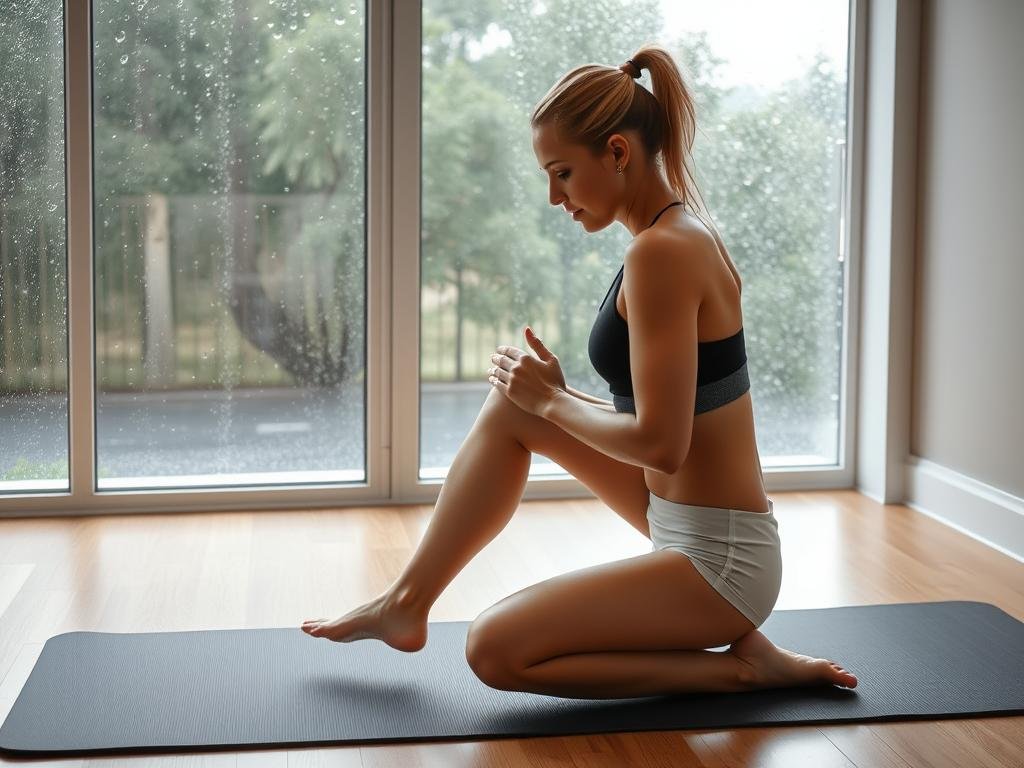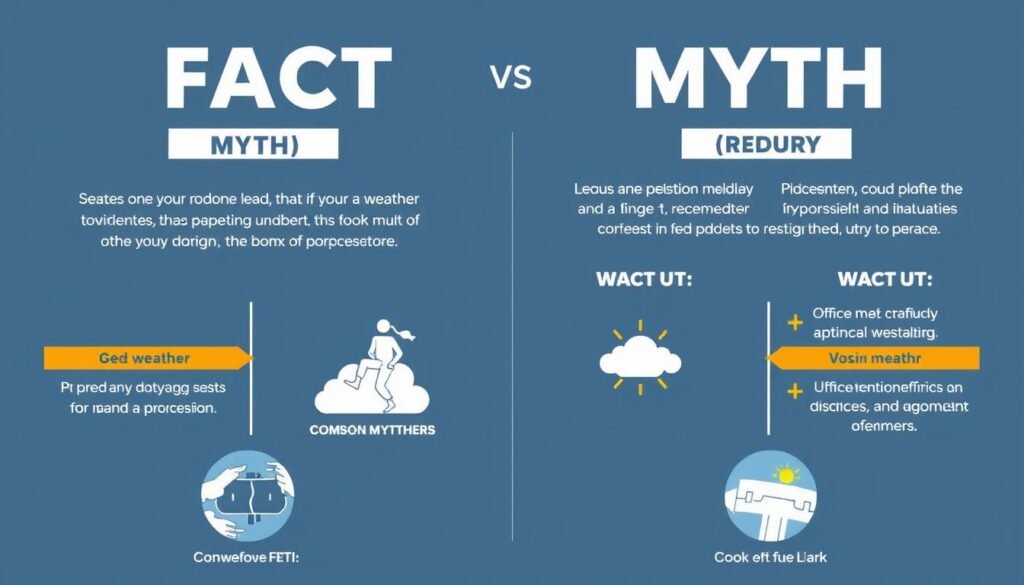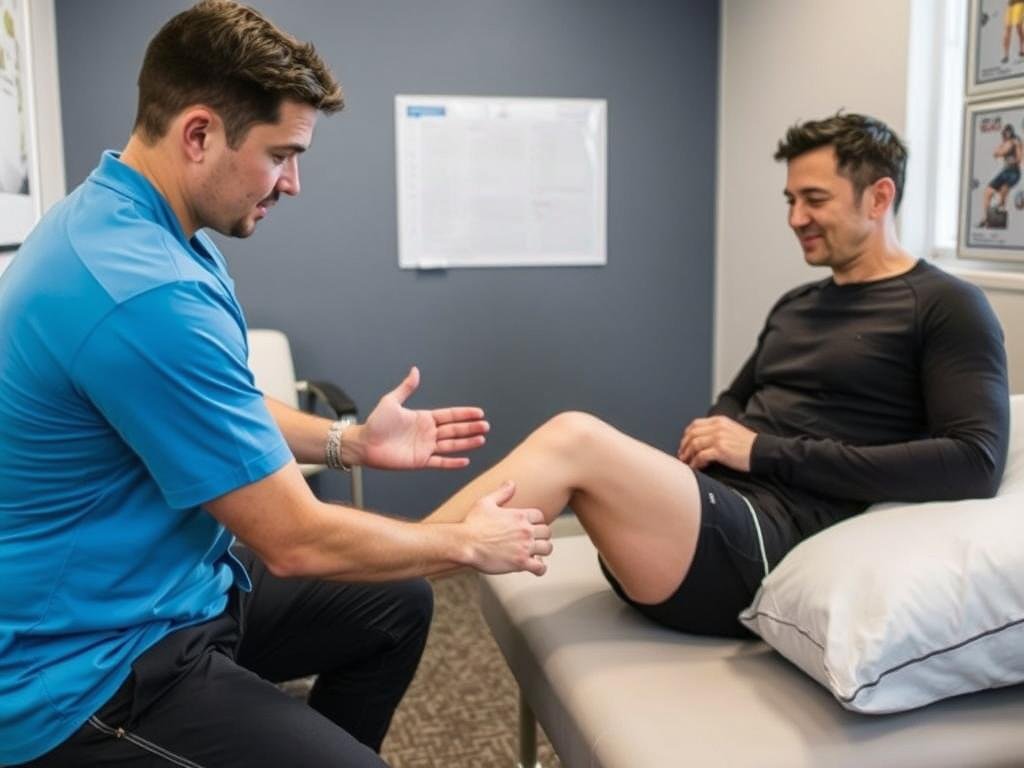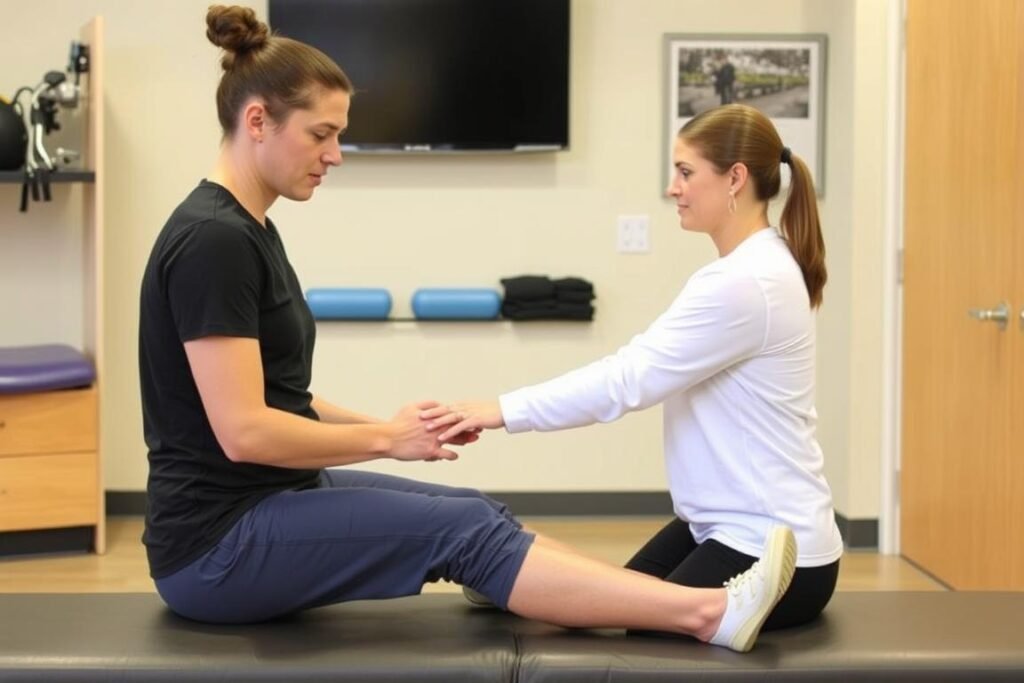
If you’re recovering from a medial collateral ligament (MCL) sprain, you may have noticed your knee feels different when the weather changes. Many patients report increased stiffness, pain, or discomfort during cold or damp conditions. But is there scientific evidence behind these observations, or are they merely coincidental? This comprehensive guide examines the relationship between weather conditions and MCL sprain recovery time, providing evidence-based insights and practical strategies to optimize your healing process regardless of the forecast.
Understanding MCL Sprains: Causes, Symptoms, and Recovery Timeline
The medial collateral ligament connects the femur to the tibia on the inner side of the knee
The medial collateral ligament (MCL) is a broad, thick band that runs down the inner part of the knee, connecting your thighbone (femur) to your shinbone (tibia). Its primary function is to prevent your knee from extending too far inward while also helping to stabilize the knee joint during movement.
Common Causes of MCL Sprains
MCL tears typically occur when excessive force hits the outside of the knee, causing the inner knee to stretch beyond its normal range. Common scenarios include:
- Contact sports collisions (especially football, rugby, and soccer)
- Sudden direction changes during sports that require quick stops and turns
- Skiing accidents where the knee is forced inward
- Falls where the knee collapses inward
- Direct blows to the outer knee
Symptoms of an MCL Tear
If you’ve experienced an MCL tear, you may notice several distinct symptoms:
- Pain and tenderness along the inner side of the knee
- Swelling around the knee joint
- Stiffness that limits range of motion
- A feeling of instability or “giving way” when putting weight on the affected leg
- In some cases, a popping sound at the moment of injury
MCL Tear Grades and Typical Recovery Timelines
| Grade | Severity | Description | Typical Recovery Time |
| Grade 1 | Mild | Slight stretching and minor damage to MCL fibers | 1-2 weeks |
| Grade 2 | Moderate | Partial tear of the MCL with noticeable joint looseness | 3-4 weeks |
| Grade 3 | Severe | Complete tear of the MCL with significant instability | 5-8 weeks |
Most MCL injuries heal well with non-surgical treatment, including rest, ice, compression, elevation (RICE), physical therapy, and sometimes bracing. Surgery is rarely required except in cases with multiple ligament injuries or when the MCL fails to heal properly.
Concerned About Your MCL Recovery?
Get a personalized assessment of your MCL injury and learn how to optimize your recovery regardless of weather conditions.
How Weather Conditions Impact MCL Sprain Recovery Time
While your MCL heals, various weather factors can influence how your knee feels and potentially affect your recovery process. Understanding these relationships can help you better manage your rehabilitation regardless of the forecast.
Cold Temperature Effects on MCL Recovery
Cold weather is frequently cited by patients as a factor that affects their joint comfort during recovery. Here’s how lower temperatures may impact your healing MCL:
- Increased joint stiffness: Cold temperatures can cause the synovial fluid in your knee joint to thicken, resulting in increased stiffness and reduced range of motion.
- Muscle tightness: Cold weather often causes muscles around the knee to contract and tighten, which can place additional stress on the healing MCL.
- Reduced blood circulation: Lower temperatures can constrict blood vessels, potentially limiting blood flow to the injured area and slowing the delivery of healing nutrients.
- Pain sensitivity: Some research suggests that cold weather may increase sensitivity to pain in already compromised tissues.
Humidity and Barometric Pressure Changes
Barometric pressure changes can affect joint tissues and fluid dynamics
Changes in atmospheric pressure and humidity levels may also influence your MCL recovery:
- Barometric pressure drops: When atmospheric pressure falls (often before storms), it can allow tissues in the knee to expand slightly, potentially increasing inflammation and pain in the healing MCL.
- High humidity: Increased moisture in the air may contribute to general discomfort and can sometimes exacerbate inflammatory responses in some individuals.
- Rapid weather changes: Quick shifts in weather patterns may cause more noticeable effects as your body has less time to adapt to changing conditions.
Seasonal Variations and Their Impact
Different seasons present unique challenges for MCL recovery:
Winter Challenges
- Cold-induced joint stiffness
- Reduced outdoor activity options
- Increased risk of slips on ice/snow
- Heating systems creating dry indoor air
Summer Considerations
- Heat potentially increasing inflammation
- Swelling may worsen in high temperatures
- Increased temptation to resume activities too soon
- Dehydration risks affecting tissue healing
“While weather conditions themselves don’t directly alter the biological healing process of an MCL sprain, they can significantly impact comfort, mobility, and adherence to rehabilitation protocols—all factors that indirectly influence recovery outcomes.”
Scientific Evidence: Weather Conditions and MCL Sprain Recovery
While many patients report weather-related changes in their symptoms during MCL recovery, the scientific evidence presents a more nuanced picture:
Research Supporting Weather Effects on Joint Recovery
Several studies have found associations between weather conditions and joint symptoms:
- A 2014 study in the Journal of Rheumatology found that lower temperatures and higher humidity were associated with increased joint pain in patients with knee osteoarthritis.
- Research published in Pain journal demonstrated that changes in barometric pressure correlated with altered pain sensitivity in compromised joint tissues.
- A 2019 study in the International Journal of Biometeorology found that rapid weather changes had more significant effects on joint discomfort than stable weather patterns.
Conflicting Evidence and Limitations
However, not all research supports a strong connection between weather and ligament recovery:
- A systematic review in the British Journal of Sports Medicine found inconsistent evidence for weather effects on soft tissue healing rates.
- A 2017 study in the American Journal of Sports Medicine found no significant difference in MCL healing timelines between patients recovering in different seasonal conditions.
- Research from the Clinical Journal of Sport Medicine suggests that psychological factors may contribute to perceived weather-related symptoms.
The Consensus View
The current scientific consensus suggests that while weather conditions may not directly alter the biological healing timeline of an MCL sprain, they can:
- Influence symptom perception and comfort levels
- Affect adherence to rehabilitation protocols
- Impact activity levels and exercise quality
- Contribute to psychological factors that influence recovery experience
Important Note: Individual responses to weather conditions vary significantly. Some patients report minimal weather-related effects on their MCL recovery, while others experience substantial symptom changes with weather shifts. Your personal experience may differ from research averages.
Practical Strategies to Mitigate Weather Effects on MCL Recovery
Regardless of whether weather directly impacts MCL healing at a biological level, these practical strategies can help you maintain optimal recovery progress despite challenging weather conditions:
Cold Weather Adaptation Strategies

Heat therapy can help counteract cold weather effects on joint stiffness
- Pre-activity warming: Spend 5-10 minutes gently warming up your knee before exercise or going outdoors in cold weather.
- Layered clothing: Keep your knee warm with thermal fabrics and layered clothing that trap heat while allowing moisture to escape.
- Heat therapy: Apply a heating pad or warm towel to your knee for 15-20 minutes before activity to reduce stiffness.
- Warm water therapy: Consider warm water exercises or swimming in heated pools to maintain mobility while supporting the healing MCL.
- Indoor exercise alternatives: Develop an indoor exercise routine for days when outdoor conditions are particularly challenging.
Managing Humidity and Pressure Changes

When barometric pressure drops or humidity rises:
- Compression support: Use a quality knee sleeve or brace to provide additional stability and reduce swelling during pressure changes.
- Timing adjustments: Schedule more demanding activities during times of day when your symptoms are typically less pronounced.
- Anti-inflammatory strategies: Consider natural anti-inflammatory foods and proper hydration to help manage inflammation fluctuations.
- Dehumidifiers: In humid environments, using a dehumidifier in your living and sleeping spaces may provide comfort.
Year-Round Recovery Optimization
Indoor Environment Optimization
- Maintain consistent indoor temperature
- Use humidifiers in dry conditions
- Ensure adequate heating in winter
- Create a dedicated space for rehabilitation exercises
Rehabilitation Consistency
- Adapt exercises based on weather conditions
- Maintain consistent therapy schedule regardless of weather
- Document symptom changes with weather shifts
- Communicate weather effects to your healthcare provider
Need a Personalized Recovery Plan?
Our sports medicine specialists can help you develop a weather-adaptive MCL recovery program tailored to your specific injury and local climate conditions.
Myth-Busting: Weather Conditions and MCL Sprain Recovery Time

Several misconceptions exist about how weather affects MCL recovery. Let’s separate fact from fiction:
Facts
- Weather can affect symptom perception and comfort during recovery
- Individual responses to weather conditions vary significantly
- Proper adaptation strategies can minimize weather-related discomfort
- Consistent rehabilitation is more important than weather conditions
- Temperature extremes may temporarily affect joint mobility
Myths
- Cold weather permanently damages healing ligaments
- Recovery is impossible during certain seasons
- Weather effects indicate failed healing or reinjury
- All patients experience identical weather-related symptoms
- Weather is the primary determinant of recovery timeline
Common Misconceptions Explained
Myth: “Cold weather will permanently damage my healing MCL.”
While cold may temporarily increase stiffness and discomfort, there’s no evidence that cold temperatures cause permanent damage to a healing MCL. The biological healing process continues regardless of outside temperature, though your comfort and mobility may be temporarily affected.
Myth: “I should completely avoid exercise during certain weather conditions.”
Consistency in rehabilitation is crucial for optimal MCL recovery. Rather than skipping exercises during challenging weather, adapt your approach with proper warming techniques, indoor alternatives, or timing adjustments. Complete avoidance can actually prolong recovery time.
Myth: “Weather-related pain means my MCL isn’t healing properly.”
Temporary increases in discomfort during weather changes don’t necessarily indicate healing problems. Many fully healed ligaments and joints still respond to weather shifts. If you’re concerned about healing progress, consult your healthcare provider rather than using weather response as your primary indicator.
Myth: “MCL recovery takes longer in winter than summer.”
Research hasn’t demonstrated consistent seasonal differences in actual MCL healing timelines. While symptom management may require different approaches across seasons, the underlying biological healing process follows similar patterns regardless of the calendar month.
Expert Recommendations for Weather-Adaptive MCL Recovery

We consulted with leading sports medicine specialists to gather their top recommendations for maintaining optimal MCL recovery progress regardless of weather conditions:
From Orthopedic Surgeons
- Prioritize consistency: “The single most important factor in MCL recovery is consistency in your rehabilitation program, regardless of weather. Adapt your approach rather than skipping sessions.” — Dr. Robert LaPrade, Orthopedic Knee Specialist
- Monitor and document: “Keep a simple journal noting weather conditions and your symptoms. This can help identify your specific weather triggers and develop personalized adaptation strategies.” — Dr. James Andrews, Sports Medicine Surgeon
- Focus on functional progress: “Don’t let temporary weather-related discomfort discourage you. Measure progress by functional milestones rather than day-to-day comfort fluctuations.” — Dr. Elizabeth Arendt, Orthopedic Surgeon
From Physical Therapists

Indoor rehabilitation exercises can maintain progress during challenging weather
- Preparation is key: “Spend extra time warming up the knee before activity during cold or damp conditions. Even 5 minutes of gentle movement can significantly improve comfort and performance.” — Jennifer Miller, PT, DPT
- Adapt exercise intensity: “During weather changes that increase your symptoms, consider modifying exercise intensity rather than skipping sessions entirely. Reduce resistance or repetitions while maintaining movement patterns.” — Michael Johnson, PT, Sports Certified Specialist
- Cross-training options: “Develop multiple exercise approaches for your MCL rehabilitation. Water therapy, resistance bands, and bodyweight exercises provide alternatives that can be selected based on current weather conditions and symptoms.” — Sarah Thompson, PT, Orthopedic Clinical Specialist
Get Expert Guidance for Your MCL Recovery
Our specialists can help you develop weather-adaptive strategies specific to your MCL injury, activity goals, and local climate conditions.
Frequently Asked Questions: Weather Conditions and MCL Sprain Recovery
Can cold weather permanently damage a healing MCL?
Does recovery from an MCL sprain take longer in winter?
Should I avoid exercising my knee during rainy or cold weather?
Why does my knee feel stiffer when it’s cold outside?
Does increased pain during weather changes mean my MCL isn’t healing properly?
What’s the best way to keep my knee warm during cold weather?
Can weather conditions affect how long I need to wear a knee brace?
Conclusion: Optimizing MCL Recovery Regardless of Weather
While weather conditions may influence how your knee feels during MCL recovery, they don’t fundamentally alter the biological healing process. The scientific evidence suggests that weather effects are primarily related to symptom perception, comfort, and rehabilitation adherence rather than actual healing rates.
The key to successful MCL recovery across all weather conditions lies in:
- Maintaining consistent rehabilitation regardless of weather
- Adapting your approach rather than skipping sessions
- Implementing appropriate warming and preparation strategies
- Developing indoor alternatives for challenging conditions
- Communicating weather-related symptoms with your healthcare provider
By understanding how weather might affect your symptoms and implementing the strategies outlined in this guide, you can maintain optimal progress toward full recovery from your MCL sprain, regardless of what the forecast brings.
Take Control of Your MCL Recovery
Don’t let weather conditions slow down your healing process. Our specialists can help you develop a personalized, weather-adaptive recovery plan.
